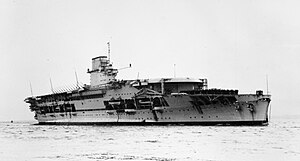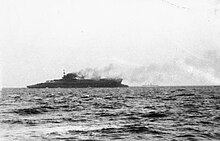HMS Courageous (50)
 Courageous shortly after completion in 1916
| |
| History | |
|---|---|
| Name | Courageous |
| Ordered | 14 March 1915 |
| Builder | Armstrong Whitworth |
| Cost | £2,038,225 |
| Yard number | 895 |
| Laid down | 26 March 1915 |
| Launched | 5 February 1916 |
| Completed | 4 November 1916 |
| Reclassified | Converted to aircraft carrier, June 1924 – February 1928 |
| Identification | Pennant number: 50 |
| Nickname(s) | Outrageous[1] |
| Fate | Sunk by U-29, 17 September 1939 |
| General characteristics as battlecruiser | |
| Class and type | Courageous-class battlecruiser |
| Displacement | |
| Length | 786 ft 9 in (239.8 m) |
| Beam | 81 ft (24.7 m) |
| Draught | 25 ft 10 in (7.9 m) |
| Installed power |
|
| Propulsion | 4 shafts; 4 geared steam turbines |
| Speed | 32 knots (59 km/h; 37 mph) |
| Range | 6,000 nmi (11,000 km; 6,900 mi) at 20 knots (37 km/h; 23 mph) |
| Complement | 842 |
| Armament |
|
| Armour |
|
 Courageous as an aircraft carrier in 1935
| |
| General characteristics as aircraft carrier | |
| Class and type | Courageous-class aircraft carrier |
| Displacement |
|
| Length | |
| Beam | 90 ft 6 in (27.6 m) (at waterline) |
| Draught | 27 ft 9 in (8.5 m) |
| Installed power |
|
| Propulsion | 4 shafts, 4 geared steam turbines |
| Speed | 30 knots (56 km/h; 35 mph) |
| Range | 5,860 nautical miles (10,850 km; 6,740 mi) at 16 knots (30 km/h; 18 mph) |
| Complement | 814 + 403 air group (1938) |
| Armament | 16 × single 4.7 in (120 mm) AA guns |
| Armour |
|
| Aircraft carried | 48 |
HMS Courageous was the
Courageous was
Origin and construction
In the First World War, Admiral Fisher was prevented from ordering an improved version of the preceding Renown-class battlecruisers by a wartime restriction that banned construction of ships larger than light cruisers in 1915. To obtain ships suitable for the doctrinal roles of battlecruisers, such as scouting for fleets and hunting enemy raiders, he settled on ships with the minimal armour of a light cruiser and the armament of a battlecruiser. He justified their existence by claiming he needed fast, shallow-draught ships for his Baltic Project, a plan to invade Germany via its Baltic coast.[1][2]
Courageous had an
The ship's normal design load was 750 long tons (762 t) of fuel oil, but she could carry a maximum of 3,160 long tons (3,211 t). At full capacity, she could steam for an estimated 6,000 nautical miles (11,110 km; 6,900 mi) at a speed of 20 knots (37 km/h; 23 mph).[5]
Courageous carried four
First World War
Courageous was
Upon commissioning, Courageous was assigned to the 3rd Light Cruiser Squadron of the
On 16 October 1917, the Admiralty received word of German ship movements, possibly indicating a raid. Admiral
Second Battle of Heligoland Bight
Throughout 1917 the Admiralty was becoming more concerned about German efforts to sweep paths through the British-laid
The German ships—four light cruisers of II Scouting Force, eight destroyers, three divisions of minesweepers, eight Sperrbrechers (cork-filled trawlers) and two other trawlers to mark the swept route—were spotted at 7:30 am.[Note 2] Courageous and the light cruiser Cardiff opened fire with their forward guns seven minutes later. The Germans responded by laying an effective smoke screen. The British continued in pursuit, but lost track of most of the smaller ships in the smoke and concentrated fire on the light cruisers. Courageous fired 92 fifteen-inch shells and 180 four-inch shells in the battle,[18] and the only damage she received was from her own muzzle blast.[19] One fifteen-inch shell hit a gun shield of the light cruiser SMS Pillau but did not affect her speed. At 9:30 the 1st Cruiser Squadron broke off their pursuit so that they would not enter a minefield marked on their maps; the ships turned south, playing no further role in the battle.[20]
After the battle, the mine fittings on Courageous were removed, and she spent the rest of the war intermittently patrolling the North Sea. In 1918, short take-off platforms were fitted for a
Between the wars
Conversion
The Washington Naval Treaty of 1922 severely limited capital ship tonnage, and the Royal Navy was forced to scrap many of its older battleships and battlecruisers. The treaty allowed the conversion of existing ships totalling up to 66,000 long tons (67,059 t) into aircraft carriers, and the Courageous class's combination of a large hull and high speed made these ships ideal candidates. The conversion of Courageous began on 29 June 1924 at Devonport.[25] Her fifteen-inch turrets were placed into storage and reused in the Second World War for HMS Vanguard, the Royal Navy's last battleship.[26] The conversion into an aircraft carrier cost £2,025,800.[27]
The ship's new design improved on her half-sister HMS Furious, which lacked an
Courageous received a
The reconstruction was completed on 21 February 1928, and the ship spent the next several months on trials and training before she was assigned to the
Air group


Courageous could carry up to 48 aircraft; following completion of her trials and embarking stores and personnel, she sailed for
From 1933 to the end of 1938 Courageous carried
Second World War and sinking

Courageous served with the Home Fleet at the start of World War II with 811 and

An earlier unsuccessful attack on Ark Royal by U-39 on 14 September, followed by the sinking of Courageous three days later, prompted the Royal Navy to withdraw its carriers from anti-submarine patrols. Courageous was the first British warship to be sunk by German forces. (The submarine Oxley had been sunk a week earlier by friendly fire from the British submarine Triton.)[41] The commander of the German submarine force, Commodore Karl Dönitz, regarded the sinking of Courageous as "a wonderful success" and it led to widespread jubilation in the Kriegsmarine (German navy). Grand Admiral Erich Raeder, commander of the Kriegsmarine, directed that Schuhart be awarded the Iron Cross First Class and that all other members of the crew receive the Iron Cross Second Class.[42]
Notes
- ^ "cwt" is the abbreviation for hundredweight, 30 cwt referring to the weight of the gun.
- ^ The times used in this article are in UTC, which is one hour behind CET, which is often used in German works.
Footnotes
- ^ a b Burt 1986, p. 303
- ^ Roberts, pp. 50–51
- ^ Roberts, pp. 64–65
- ^ Roberts, pp. 71, 76, 79
- ^ a b c Burt 1986, p. 306
- ^ Burt 1986, p. 294
- ^ a b Roberts, p. 54
- ^ Burt 1986, p. 309
- ^ Burt 1986, pp. 309, 313
- ^ Burt 1986, p. 307
- ^ Parkes, p. 621
- ^ McBride, p. 109
- ^ a b Burt 1986, p. 314
- ^ a b "Private papers of Sir Trevylyan Napier". Imperial War Museum. Retrieved 22 November 2011.
- ^ Newbolt, pp. 150–51
- ^ Newbolt, pp. 156–57
- ^ Newbolt, pp. 164–65
- ^ Campbell, p. 67
- ^ McBride, p. 115
- ^ McBride, pp. 110–12
- ^ Campbell, p. 66
- ^ Burt 1986, p. 315
- ^ "Meyrick, Sir Sidney Julius (1879–1973), Admiral". Liddell Hart Centre for Military Archives. Retrieved 22 November 2011.
- ^ Navy List 1921
- ^ Burt 1993, pp. 273, 285
- ^ Parkes, p. 647
- ^ "An Over-Age Ship More Vulnerable Than Latest Designs". News. The Times. No. 48414. London. 19 September 1939. col C, p. 8.
- ^ Brown, D., p. 2
- ^ Friedman, pp. 103, 105–06
- ^ Burt 1993, pp. 274–78
- ^ Burt 1993, pp. 165, 278, 281
- ^ a b Burt 1993, pp. 281, 285
- ^ Sturtivant Air EnthusiastSeptember–December 1988, p. 13.
- ^ a b
"HMS Courageous". Air-Britain Aeromiltaria (3). Shepperton, Middlesex: ISSN 0262-8791.
- ^ Sturtivant, pp. 155, 157–58
- ^ Sturtivant, pp. 197, 200, 243, 247, 250, 252
- ^ Sturtivant, pp. 161, 164–65, 203–04
- ^ Brown, J.D., p. 12
- ^ Burt 1993, pp. 286–88
- ^ Blair, pp. 90–91
- ^ Rohwer, pp. 1–3
- ^ Blair, p. 91
References
- ISBN 0-394-58839-8.
- ISBN 0-668-04164-1.
- Brown, J. D. (2009). Carrier Operations in World War II. Annapolis, Maryland: Naval Institute Press. ISBN 978-1-59114-108-2.
- Burt, R. A. (1986). British Battleships of World War One. Annapolis, Maryland: Naval Institute Press. ISBN 0-87021-863-8.
- Burt, R. A. (1993). British Battleships, 1919–1939. London: Arms and Armour Press. ISBN 1-85409-068-2.
- Campbell, N. J. M. (1978). Battle Cruisers: The Design and Development of British and German Battlecruisers of the First World War Era. Warship Special. Vol. 1. Greenwich, UK: Conway Maritime Press. ISBN 0-85177-130-0.
- ISBN 0-87021-054-8.
- McBride, Keith (1990). "The Weird Sisters". In Gardiner, Robert (ed.). Warship 1990. Annapolis, Maryland: Naval Institute Press. pp. 93–101. ISBN 1-55750-903-4.
- ISBN 0-89839-255-1.
- ISBN 1-55750-075-4.
- Roberts, John (1997). Battlecruisers. Annapolis, Maryland: Naval Institute Press. ISBN 1-55750-068-1.
- ISBN 1-59114-119-2.
- ISSN 0143-5450.
- Sturtivant, Ray (1984). The Squadrons of the Fleet Air Arm. Tonbridge, Kent, UK: Air-Britain (Historians). ISBN 0-85130-120-7.
External links
- Photo gallery of Courageous and Glorious
- Data on as-fitted design and equipment
- IWM Interview with survivor Walter Young
- IWM Interview with survivor Gordon Smerdon
- IWM Interview with survivor Patrick Cannon
